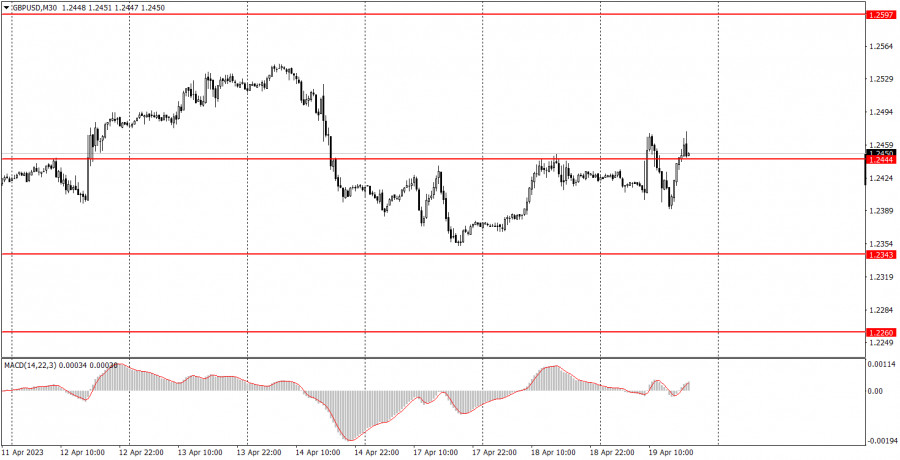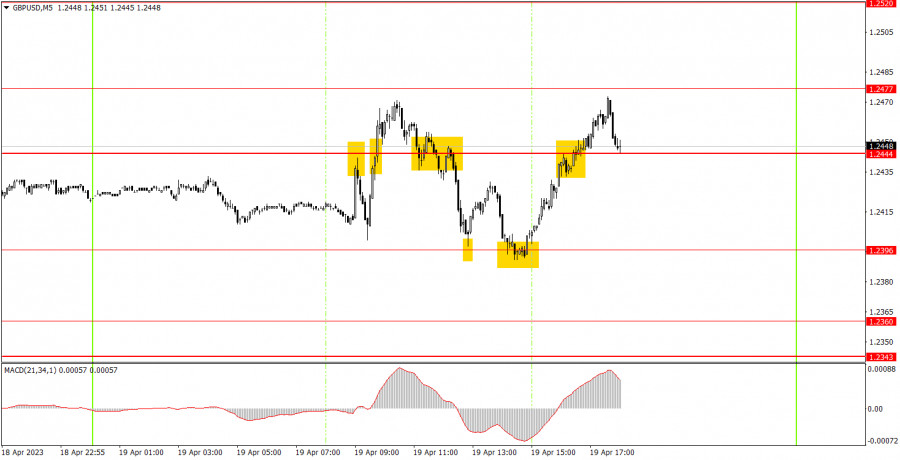

The GBP/USD pair traded in different directions on Wednesday, which was likely provoked by the resonant report on British inflation. Recall that inflation in the EU and the US is falling at quite impressive rates, showing positive results of the central banks' work. In the UK, inflation fell by 0.3% in March, remaining above the 10% level, and has only dropped a total of 1% from its peak. Obviously, this is very little for 11 key rate hikes. Since each new absence of inflation decline or weak decline or its growth does not mean that the Bank of England will continue to tighten monetary policy again and again, the British pound no longer has the support of this factor. And today, the market simply did not know how to react to another disappointing report. The day before, it even bought the pound after Britain came out with weak data. Therefore, there is still little to no logic in the pair's movements. The pair continues to correct against the correction against the preceding upward movement.
GBP/USD on 5M chart
Trading signals on the 5-minute chart were very contradictory on Wednesday. First of all, it was logical to consider the levels 1.2444 and 1.2477 as an area since the distance between them was only 33 points. This is not much, but not little either. We considered them separately just in case. But no matter how we looked at them, the trading signals did not improve. The first two signals around 1.2444 turned out to be false, and it was not the levels, but the British data that was to blame. Therefore, traders should not have followed the next two signals around the same level. The first trade closed at a break-even stop loss, while the second one closed at a small loss. Bounces from the 1.2396 level resulted in a break-even stop loss and a profit of about 55 points, which completely covered the loss from the second trade. In total, a small profit was made, but trading was quite challenging.
Trading tips on Thursday:On the 30-minute chart, GBP/USD entered a bearish correction, which may end very quickly (if it hasn't already). I believe that the pound should have fallen a long time ago, and there are far more reasons to support this than its further growth. However, the market may think differently. The 1.2444 level could act as a serious resistance for bulls, so I expect the pound to fall. On the 5-minute chart, it is recommended to trade at the levels 1.2171-1.2179, 1.2245-1.2260, 1.2343-1.2360, 1.2396, 1.2444, 1.2477, 1.2520, 1.2577-1.2597-1.2616. As soon as the price passes 20 pips in the right direction, you should set a Stop Loss to breakeven. The UK and the US do not have any important reports or events planned on Thursday. Therefore, traders will have nothing to react to. Volatility may be low, and there will probably be no trend.
Basic rules of the trading system:1) The strength of the signal is determined by the time it took the signal to form (a rebound or a breakout of the level). The quicker it is formed, the stronger the signal is.
2) If two or more positions were opened near a certain level based on a false signal (which did not trigger a Take Profit or test the nearest target level), then all subsequent signals at this level should be ignored.
3) When trading flat, a pair can form multiple false signals or not form them at all. In any case, it is better to stop trading at the first sign of a flat movement.
4) Trades should be opened in the period between the start of the European session and the middle of the US trading hours when all positions must be closed manually.
5) You can trade using signals from the MACD indicator on the 30-minute time frame only amid strong volatility and a clear trend that should be confirmed by a trendline or a trend channel.
6) If two levels are located too close to each other (from 5 to 15 pips), they should be considered support and resistance levels.
On the chart:Support and Resistance levels are the levels that serve as targets when buying or selling the pair. You can place Take Profit near these levels.
Red lines are channels or trend lines that display the current trend and show in which direction it is better to trade now.
The MACD indicator (14, 22, and 3) consists of a histogram and a signal line. When they cross, this is a signal to enter the market. It is recommended to use this indicator in combination with trend patterns (channels and trendlines).
Important announcements and economic reports that can be found on the economic calendar can seriously influence the trajectory of a currency pair. Therefore, at the time of their release, we recommend trading as carefully as possible or exiting the market in order to avoid sharp price fluctuations.
Beginners on Forex should remember that not every single trade has to be profitable. The development of a clear strategy and money management is the key to success in trading over a long period of time.